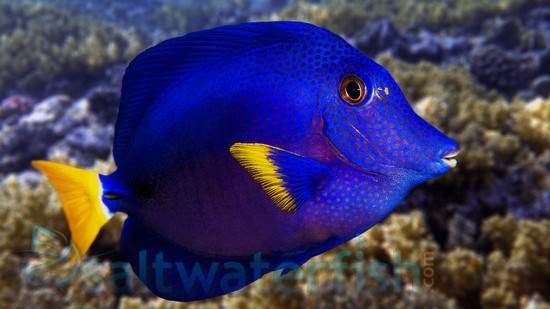The Spotted Watchman Goby (Cryptocentrus cinctus) known to tropical fish keeping enthusiasts as the Yellow Prawn Goby, Yellow Watchman Goby, Sulphur Goby, or Banded Prawn Goby is found in the tropical waters of the Indian Ocean, the Central West Pacific Ocean, and the Red Sea.
Their range extends from the Yaeyama Islands, Japan to Singapore and the southern Great Barrier Reef; Palau and Truk in Micronesia.
There are currently 35 recognized species of Watchman Gobies in the genus Cryptocentrus that are generally known as Shrimp Goby or Prawn Goby, all native to the Pacific and Indian oceans, which we have listed below in alphabetical order:
Cryptocentrus albidorsus (Yanagisawa, 1978) (White-backed shrimpgoby)
Cryptocentrus bulbiceps (Whitley, 1953) (Bluelined shrimpgoby)
Cryptocentrus caeruleomaculatus (Herre, 1933) (Blue-speckled prawn-goby)
Cryptocentrus caeruleopunctatus (Rüppell, 1830) (Harlequin prawn-goby)
Cryptocentrus callopterus H. M. Smith, 1945
Cryptocentrus cebuanus Herre, 1927 (Cebu shrimpgoby)
Cryptocentrus cinctus (Herre, 1936) (Yellow prawn-goby)
Cryptocentrus cryptocentrus (Valenciennes, 1837) (Ninebar prawn-goby)
Cryptocentrus cyanospilotus G. R. Allen & J. E. Randall, 2011 (Bluespot shrimpgoby)
Cryptocentrus cyanotaenia (Bleeker, 1853) (Lagoon shrimpgoby)
Cryptocentrus diproctotaenia Bleeker, 1876
Cryptocentrus epakros G. R. Allen, 2015 (Pointedfin shrimpgoby) [1]
Cryptocentrus fasciatus (Playfair (fr), 1867) (Y-bar shrimpgoby)
Cryptocentrus flavus Yanagisawa, 1978
Cryptocentrus inexplicatus (Herre, 1934) (Inexplicable shrimpgoby)
Cryptocentrus insignitus (Whitley, 1956) (Signal goby)
Cryptocentrus leonis H. M. Smith, 1931
Cryptocentrus leptocephalus Bleeker, 1876 (Pink-speckled shrimpgoby)
Cryptocentrus leucostictus (Günther, 1872) (Saddled prawn-goby)
Cryptocentrus lutheri Klausewitz, 1960 (Luther’s prawn-goby)
Cryptocentrus malindiensis (J. L. B. Smith, 1959)
Cryptocentrus maudae Fowler, 1937 (Maude’s shrimpgoby)
Cryptocentrus melanopus (Bleeker, 1860)
Cryptocentrus multicinctus G. R. Allen & J. E. Randall, 2011 (Multibarred shrimpgoby)
Cryptocentrus nigrocellatus (Yanagisawa, 1978)
Cryptocentrus niveatus (Valenciennes, 1837)
Cryptocentrus octofasciatus Regan, 1908 (Blue-speckled prawn-goby)
Cryptocentrus pavoninoides (Bleeker, 1849)
Cryptocentrus polyophthalmus (Bleeker, 1853)
Cryptocentrus pretiosus (Rendahl (de), 1924)
Cryptocentrus shigensis N. Kuroda, 1956 (Shige shrimpgoby)
Cryptocentrus strigilliceps (D. S. Jordan & Seale, 1906) (Target shrimpgoby)
Cryptocentrus tentaculatus Hoese & Larson, 2004 (Tentacle shrimpgoby)
Cryptocentrus wehrlei Fowler, 1937
Cryptocentrus yatsui Tomiyama, 1936
The Spotted Watchman Goby (Cryptocentrus cinctus) is a shy, curious species that is found alone, in pairs, and sharing burrows with “pistol shrimps” in the sandy bottoms of the coastal reefs, mangrove swamps, lagoons, and tidal pools of their range, at depths from 3 to over 80 feet.
The Spotted Watchman Goby is a color variety of the Yellow Prawn Goby found in the Philippines that forms symbiotic relationships with alpheid shrimps; often sharing burrows with them.
The Spotted Watchman Goby is an elongated species with large protruding eyes set high on the head, and a large turned down mouth. Its body color can vary greatly in appearance from brilliant yellow, to gray, to a subdued brown with small iridescent blue spots that decorate the body, head, and fins in a jewel like pattern.
The Spotted Watchman Goby is believed to be sexually dichromatic. The males are a bright
yellow color and the females are grayish colored, with both having blue dots along the body.
The Spotted Watchman Goby can be housed in a mature FOWLR or reef aquarium of at least 30 gallon capacity with a sand or fine coralline gravel substrate, plenty of live rock and loose coral rubble for them to burrow among, and plenty of swimming space. They have been known to jump from their tank so a tight fitting cover is recommended, especially for
smaller aquariums.
The Spotted Watchman Goby or Yellow Prawn Goby is seldom aggressive towards other peaceful species, however it is territorial with its burrow and except for mated pairs, will fight with its own kind. In larger tanks, they are less quarrelsome with conspecifics.
The Spotted Watchman Goby will often form a symbiotic relationship with Tiger Pistol Shrimp (Alpheus bellulus) in the aquarium and share the same burrow. The shrimp have limited eye sight and need the goby to alert them of predators. The watchman goby warns the shrimp when predators are close and in turn uses the shrimps burrow as a shelter.
Cryptocentrus cinctus have been successfully bred in an aquarium environment. Mated pairs breed readily and frequently. The tiny eggs hatch out after only four days of incubation. Initially they should be fed S strain rotifers. After about fourteen days they should be switched over to L Strain rotifers and after 28 days, they can be offered newly hatched baby brine shrimp.
The Spotted Watchman Goby is a carnivore that will accept most meaty foods including mysis shrimp, enriched brine shrimp, finely chopped table shrimp, frozen carnivore preparations and sinking pellet foods. They should be fed at least two times per day.
The Spotted Watchman Goby (Cryptocentrus cinctus) is commonly available to tropical fish keeping enthusiasts as wild caught or commercially bred specimens from a variety of online retailers, wholesalers, and transhippers at the following approximate purchase sizes: Small: 1″ to 2″; Medium: 2″ to 3″; Large: 3″ to 4″. Prices for medium size specimens start at around $ 39.99.
Minimum Tank Size: 30 gallons
Aquarium Type: Reef or FOLR
Care Level: Easy
Temperament: Peaceful
Aquarium Hardiness: Hardy
Water Conditions: 72-79° F, dKH 8 – 12°, pH 8.1–8.4, sg 1.020-1.025
Max size: 4″
Color Form: Blue, Brown, Yellow
Diet: Carnivore
Compatibility: Reef Safe
Origin: Western Pacific, Indian Ocean
Family: Gobiidae
Lifespan: 10 years
Aquarist Experience Level: Intermediate





